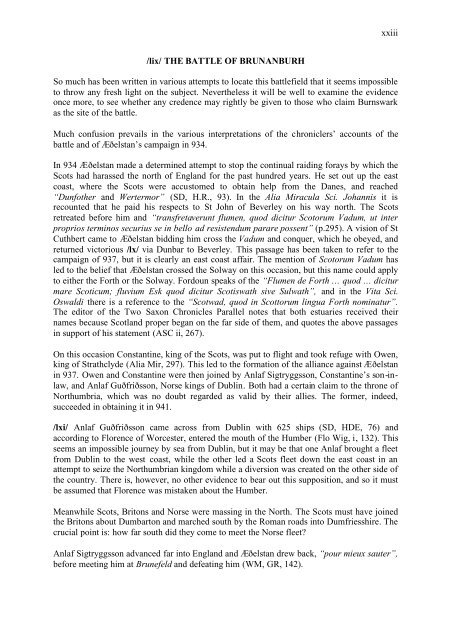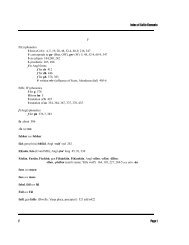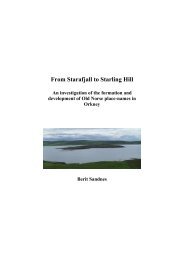May Williamson: The Non-Celtic Place-Names of the Scottish Border ...
May Williamson: The Non-Celtic Place-Names of the Scottish Border ...
May Williamson: The Non-Celtic Place-Names of the Scottish Border ...
Create successful ePaper yourself
Turn your PDF publications into a flip-book with our unique Google optimized e-Paper software.
xxiii<br />
/lix/ THE BATTLE OF BRUNANBURH<br />
So much has been written in various attempts to locate this battlefield that it seems impossible<br />
to throw any fresh light on <strong>the</strong> subject. Never<strong>the</strong>less it will be well to examine <strong>the</strong> evidence<br />
once more, to see whe<strong>the</strong>r any credence may rightly be given to those who claim Burnswark<br />
as <strong>the</strong> site <strong>of</strong> <strong>the</strong> battle.<br />
Much confusion prevails in <strong>the</strong> various interpretations <strong>of</strong> <strong>the</strong> chroniclers’ accounts <strong>of</strong> <strong>the</strong><br />
battle and <strong>of</strong> Æðelstan’s campaign in 934.<br />
In 934 Æðelstan made a determined attempt to stop <strong>the</strong> continual raiding forays by which <strong>the</strong><br />
Scots had harassed <strong>the</strong> north <strong>of</strong> England for <strong>the</strong> past hundred years. He set out up <strong>the</strong> east<br />
coast, where <strong>the</strong> Scots were accustomed to obtain help from <strong>the</strong> Danes, and reached<br />
“Dunfo<strong>the</strong>r and Wertermor” (SD, H.R., 93). In <strong>the</strong> Alia Miracula Sci. Johannis it is<br />
recounted that he paid his respects to St John <strong>of</strong> Beverley on his way north. <strong>The</strong> Scots<br />
retreated before him and “transfretaverunt flumen, quod dicitur Scotorum Vadum, ut inter<br />
proprios terminos securius se in bello ad resistendum parare possent” (p.295). A vision <strong>of</strong> St<br />
Cuthbert came to Æðelstan bidding him cross <strong>the</strong> Vadum and conquer, which he obeyed, and<br />
returned victorious /lx/ via Dunbar to Beverley. This passage has been taken to refer to <strong>the</strong><br />
campaign <strong>of</strong> 937, but it is clearly an east coast affair. <strong>The</strong> mention <strong>of</strong> Scotorum Vadum has<br />
led to <strong>the</strong> belief that Æðelstan crossed <strong>the</strong> Solway on this occasion, but this name could apply<br />
to ei<strong>the</strong>r <strong>the</strong> Forth or <strong>the</strong> Solway. Fordoun speaks <strong>of</strong> <strong>the</strong> “Flumen de Forth … quod … dicitur<br />
mare Scoticum; fluvium Esk quod dicitur Scotiswath sive Sulwath”, and in <strong>the</strong> Vita Sci.<br />
Oswaldi <strong>the</strong>re is a reference to <strong>the</strong> “Scotwad, quod in Scottorum lingua Forth nominatur”.<br />
<strong>The</strong> editor <strong>of</strong> <strong>the</strong> Two Saxon Chronicles Parallel notes that both estuaries received <strong>the</strong>ir<br />
names because Scotland proper began on <strong>the</strong> far side <strong>of</strong> <strong>the</strong>m, and quotes <strong>the</strong> above passages<br />
in support <strong>of</strong> his statement (ASC ii, 267).<br />
On this occasion Constantine, king <strong>of</strong> <strong>the</strong> Scots, was put to flight and took refuge with Owen,<br />
king <strong>of</strong> Strathclyde (Alia Mir, 297). This led to <strong>the</strong> formation <strong>of</strong> <strong>the</strong> alliance against Æðelstan<br />
in 937. Owen and Constantine were <strong>the</strong>n joined by Anlaf Sigtryggsson, Constantine’s son-inlaw,<br />
and Anlaf Guðfriðsson, Norse kings <strong>of</strong> Dublin. Both had a certain claim to <strong>the</strong> throne <strong>of</strong><br />
Northumbria, which was no doubt regarded as valid by <strong>the</strong>ir allies. <strong>The</strong> former, indeed,<br />
succeeded in obtaining it in 941.<br />
/lxi/ Anlaf Guðfriðsson came across from Dublin with 625 ships (SD, HDE, 76) and<br />
according to Florence <strong>of</strong> Worcester, entered <strong>the</strong> mouth <strong>of</strong> <strong>the</strong> Humber (Flo Wig, i, 132). This<br />
seems an impossible journey by sea from Dublin, but it may be that one Anlaf brought a fleet<br />
from Dublin to <strong>the</strong> west coast, while <strong>the</strong> o<strong>the</strong>r led a Scots fleet down <strong>the</strong> east coast in an<br />
attempt to seize <strong>the</strong> Northumbrian kingdom while a diversion was created on <strong>the</strong> o<strong>the</strong>r side <strong>of</strong><br />
<strong>the</strong> country. <strong>The</strong>re is, however, no o<strong>the</strong>r evidence to bear out this supposition, and so it must<br />
be assumed that Florence was mistaken about <strong>the</strong> Humber.<br />
Meanwhile Scots, Britons and Norse were massing in <strong>the</strong> North. <strong>The</strong> Scots must have joined<br />
<strong>the</strong> Britons about Dumbarton and marched south by <strong>the</strong> Roman roads into Dumfriesshire. <strong>The</strong><br />
crucial point is: how far south did <strong>the</strong>y come to meet <strong>the</strong> Norse fleet<br />
Anlaf Sigtryggsson advanced far into England and Æðelstan drew back, “pour mieux sauter”,<br />
before meeting him at Brunefeld and defeating him (WM, GR, 142).




